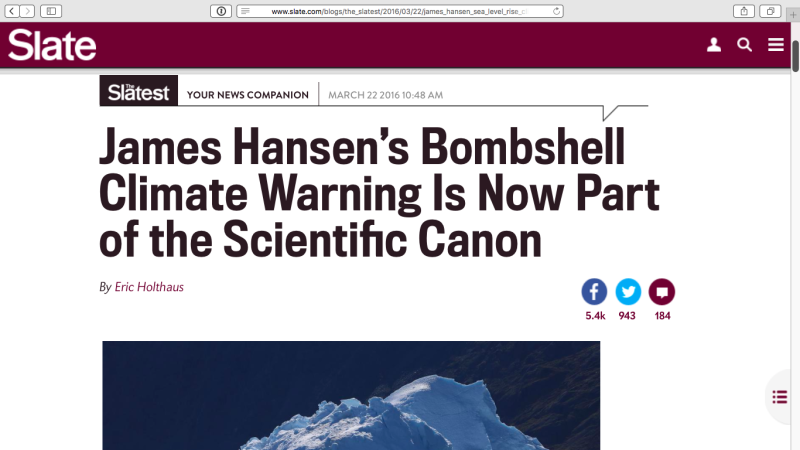Of Science, Activism, and Journalism
Climate science is rarely upbeat, but the headlines attending the release of a new paper, published last week in the journal Atmospheric Chemistry and Physics, were particularly frightening. At The New York Times: “Scientists Warn of Perilous Climate Shift Within Decades, Not Centuries.” And while its story was measured, The Washington Post’s headline went for straight-up panic, cautioning, “We Had All Better Hope These Climate Scientists Are Wrong.”
Curiously missing from all the coverage, however, was the Associated Press. Seth Borenstein, who covers climate change for the news agency, said he chose to opt-out of writing about the paper entirely. After emailing six researchers — a mix of climate scientists and oceanographers — Borenstein says five expressed hesitancy with the methods of the study, so he decided to stand down.
“When I get this much warning or caution, it tells me that, at least for the AP, the study doesn’t quite merit coverage,” he said.
The new paper — over 60 pages long — models how ice melt from Antarctica and Greenland might create a feedback loop, accelerating sea level rise by several meters, virtually destroying coastal cities around the globe. It predicts that this shift in climate might be triggered by a global average temperature increase of just 2 degrees Celsius over pre-industrial levels — a milestone that society is already halfway to reaching, and a threshold that governments have largely embraced as a safe.
The paper was authored by a 19-person team headed-up by James Hansen.
Hansen is a fine scientist, famous for Cassandra-like warnings that often turn out to be accurate. But in recent years, he has also become something of a scholar-activist, giving Ted talks, joining climate protests, and stepping down from a position at NASA to run the Awareness and Solutions Program at Columbia University.
In Hansen’s view, global institutions like the Intergovernmental Panel on Climate Change, which has sought over the last three decades to aggregate and distill scientists’ best sense of how bad things might get (and how quickly), are too conservative. The global warming problem, he says, requires much more forceful interventions to forestall potentially cataclysmic changes.
That’s partly why a draft of his new paper was released last summer and fast-tracked to the public ahead of global climate talks that were held in Paris in December. The early release also provided support for a lawsuit, brought by Hansen and others against the Obama administration, for failing to take immediate measures to protect the public from the effects of climate change.
Writing for The New Yorker magazine at the time of the paper’s first release, environment writer Elizabeth Kolbert — who documented Hansen’s transition toward activism in a 2009 profile — suggested that it revealed just how much scientists still disagree on both the timeline and scale of the effects of climate change. Even in the more recent release of the paper, the title was softened from its original declaration that 2-degrees Celsius of warming “is highly dangerous” to the more circumspect assertion that it “could be dangerous.”
In an email message to Undark, Hansen says this was a concession to journal publication that he disagreed with. “You do not need 100 percent proof that you will be murdered if you walk down a threatening street,” he said, “to decide that it is dangerous and you should not walk down it.”
Still, the larger premise of the paper hasn’t changed much since being first released last summer, and its progression through peer review was heralded by a video abstract, a press conference, and a wave of coverage. “The relevant scientific community, in our opinion, has been exercising self-censorship in its warning to the public about the danger of human-made climate change,” Hansen wrote as the paper was officially released last week.
So Hansen is a brilliant and pedigreed scientist with a clear agenda, which raises the question: How should his research be interpreted and approached by journalists?
Hansen, for one, says that championing policy is a natural offshoot of his work as a scientist, rather than an impairment of his objectivity, and has “nothing to do with the quality of the science.”
“Is a medical doctor smeared as an ‘activist’ because he says that people’s lives or health are threatened by some food or practice?” Hansen asked in his email to me. “For scientists to point out [a clear] climate change danger and publicize [it isn’t] any different. It would be malpractice if we did not do whatever we can to protect young people and other life.”
Borenstein, who said the scientists he contacted considered Hansen’s models to be “low-resolution,” added that he was particularly troubled by Hansen’s use of his own paper as evidence to support his campaign for urgent action. Watching the press conference, Borenstein said, “the mix of both advocacy talk and science talk really did set off flags for me.”
The divide between Hansen’s view — that climate science can’t exist within a vacuum — and Borenstein’s concern over advocacy was illustrated best in a press call before the study. About fifteen minutes into the conference call, a recording of which was shared with Undark by a reporter on the call, Borenstein asks Hansen whether the peer reviewed draft of the study addresses concerns of many climate scientists who said it made “large extrapolations” when it was first debuted.
Hansen seemingly skirts the question. “Of course we’re forced to try to look into the future because of the danger,” he told reporters on the call. “If we don’t do that, if you just wait until things happen, then it’s too late. That’s the point I’m trying to make: That we’re in danger of passing the point of no return on both of these issues.”
The point Hansen’s making, though controversial, is one he’s made countless times in the past: If the stakes are high enough, it’s important to make “large extrapolations” — to model not just the likely outcome, but the worst possible outcome, and to make that widely known.
“I considered it something of a thought project,” said Eric Holthaus, a climate writer for Slate, who covered the second release with a dramatic title “James Hansen’s Bombshell Climate Warning Is Now Part of the Scientific Canon.” Though the title has drawn some criticism, Holthaus stands by his opinion that Hansen’s release is a central contribution to climate science.
“It’s important enough where, even if it turns out to be inaccurate, people will still refer back to it for years to come,” says Holthaus. “That’s why I said ‘cautious praise’ in my piece — it’s about as good as you can expect from entertaining such a dramatic scenario.”
Other publications chose to take a purposefully cautious stance, in part because of the resources required to fully examine the paper. Jack Cushman, managing editor of InsideClimate News, assigned a short and curtly-reported piece, in order to get on the record but bow out of the attending debate. “I hope we will have a larger examination of this question at some point in the future,” he said in an interview. “But we didn’t have the bandwidth for that and I didn’t want to wait.”
“I would never put myself in the position of kind of casually criticizing Hansen’s scientific work or credibility,” Cushman added, “because I’m in no position to do so.”












